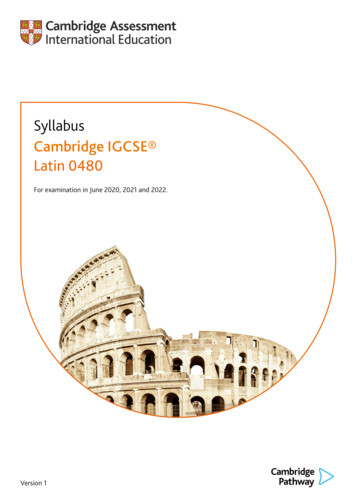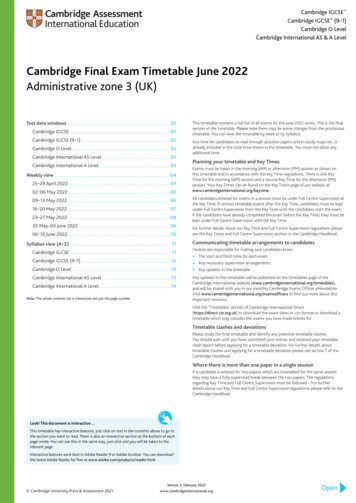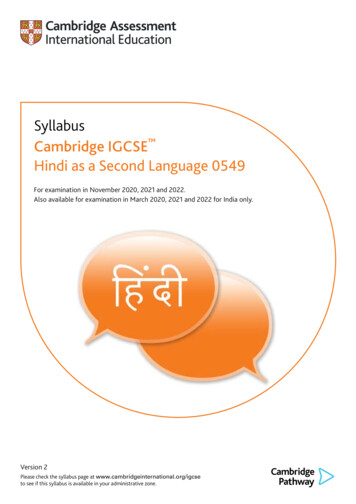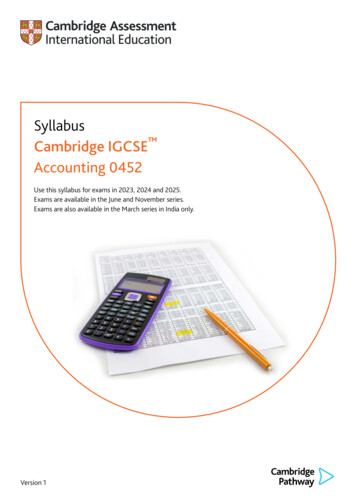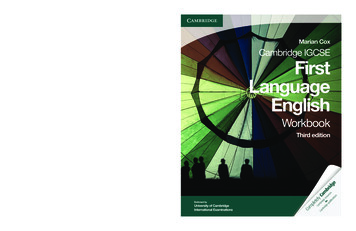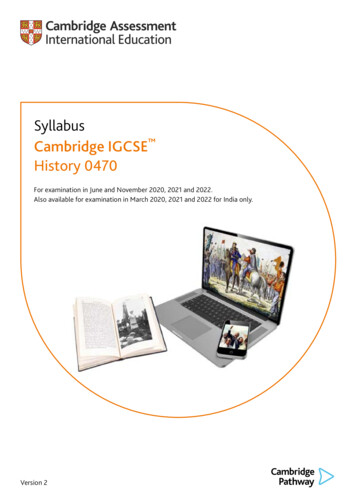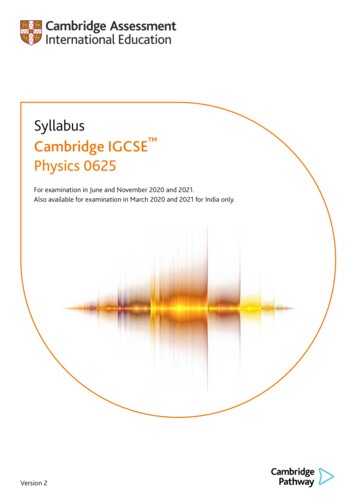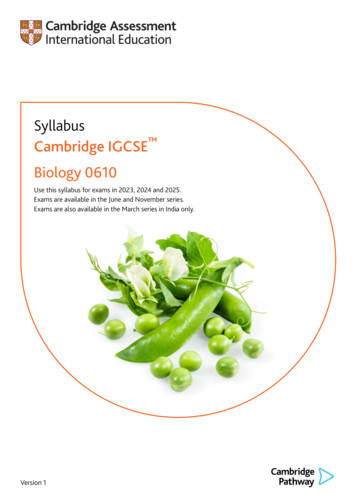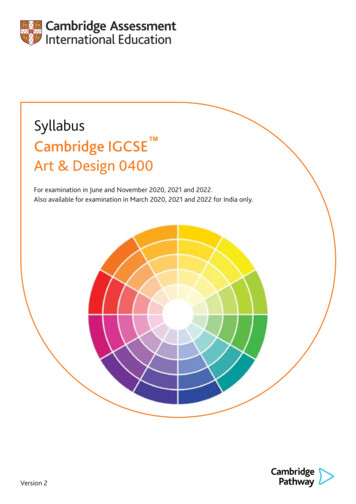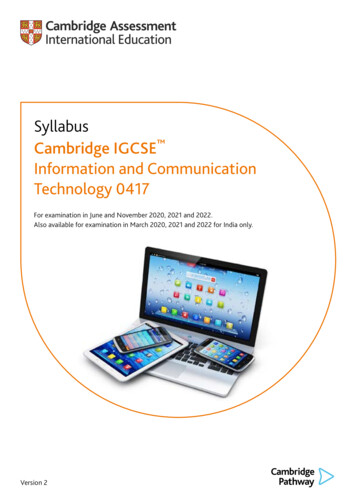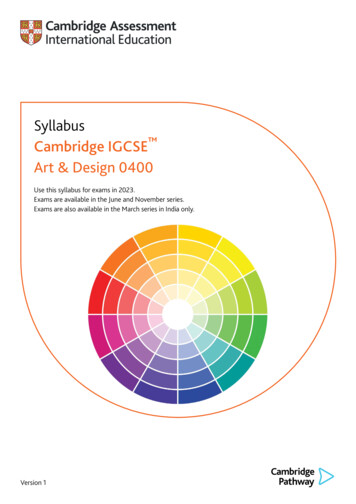
Transcription
SyllabusCambridge IGCSE Art & Design 0400Use this syllabus for exams in 2023.Exams are available in the June and November series.Exams are also available in the March series in India only.Version 1
Why choose Cambridge International?Cambridge International prepares school students for life, helping them develop an informed curiosity and a lastingpassion for learning. We are part of the University of Cambridge.Our Cambridge Pathway gives students a clear path for educational success from age 5 to 19. Schools can shapethe curriculum around how they want students to learn – with a wide range of subjects and flexible ways to offerthem. It helps students discover new abilities and a wider world, and gives them the skills they need for life, so theycan achieve at school, university and work.Our programmes and qualifications set the global standard for international education. They are created by subjectexperts, rooted in academic rigour and reflect the latest educational research. They provide a strong platform forlearners to progress from one stage to the next, and are well supported by teaching and learning resources.Our mission is to provide educational benefit through provision of international programmes and qualifications forschool education and to be the world leader in this field. Together with schools, we develop Cambridge learnerswho are confident, responsible, reflective, innovative and engaged – equipped for success in the modern world.Every year, nearly a million Cambridge students from 10 000 schools in 160 countries prepare for their future withthe Cambridge Pathway.‘We think the Cambridge curriculum is superb preparation for university.’Christoph Guttentag, Dean of Undergraduate Admissions, Duke University, USAQuality managementCambridge International is committed to providing exceptional quality. In line with this commitment, ourquality management system for the provision of international qualifications and education programmesfor students aged 5 to 19 is independently certified as meeting the internationally recognised standard,ISO 9001:2015. Learn more at www.cambridgeinternational.org/ISO9001Copyright UCLES September 2020Cambridge Assessment International Education is part of the Cambridge Assessment Group. Cambridge Assessment is the brand name ofthe University of Cambridge Local Examinations Syndicate (UCLES), which itself is a department of the University of Cambridge.UCLES retains the copyright on all its publications. Registered centres are permitted to copy material from this booklet for their owninternal use. However, we cannot give permission to centres to photocopy any material that is acknowledged to a third party even forinternal use within a centre.
Contents1 Why choose this syllabus? . 22 Syllabus overview . 5Aims5Content overview5Assessment overview6Assessment objectives73 Subject content .8Skills and understanding common to all areas of study8Painting and related media9Graphic communication10Three-dimensional design11Textiles and fashion12Photography134 Details of the assessment .14Component 1 – Coursework14Component 2 – Externally Set Assignment15Avoidance of plagiarism16Assessment criteria for Component 1 and Component 2175 What else you need to know .18Before you start18Making entries19After the exam20How students and teachers can use the grades20Grade descriptions20Changes to this syllabus for 202321Important: Changes to this syllabusFor information about changes to this syllabus for 2023, go to page 21.The latest syllabus is version 1, published September 2020. There are no significant changes which affectteaching.Any textbooks endorsed to support the syllabus for examination from 2020 are still suitable for use with thissyllabus.
Cambridge IGCSE Art & Design 0400 syllabus for 2023.1 Why choose this syllabus?Key benefitsCambridge IGCSE is the world’s most popular international qualification for 14 to 16 year olds, although it can betaken by students of other ages. It is tried, tested and trusted.Students can choose from 70 subjects in any combination – it is taught by over 4800 schools in over 150 countries.Our programmes balance a thorough knowledge and understanding of a subject and help to develop the skillslearners need for their next steps in education or employment.Cambridge IGCSE Art & Design encourages a range of skills, stimulates aesthetic awareness, knowledge and criticalunderstanding of art, and provides opportunities for learners to develop a range of skills. Crucially, a personal andindependent perspective is encouraged at all times. The syllabus is designed to accommodate a wide range ofabilities, materials and resources, and allows the different skills of the teaching staff to be fully used.The syllabus appeals to learners who wish to explore practical work through a range of two- and/orthree-dimensional processes and include new media and technologies in addition to traditional media andprocesses.The syllabus helps equip learners with lifelong skills including: confidence and enthusiasm as they develop technical skills in two- and/or three-dimensional form andcomposition the ability to identify and solve problems in visual and tactile forms the ability to develop ideas from initial attempts to outcomes.Our programmes balance a thorough knowledge and understanding of a subject and help to develop the skillslearners need for their next steps in education or employment.Our approach in Cambridge IGCSE Art & Design encourages learners to be:Cambridgelearner‘The strength of Cambridge IGCSE qualifications is internationally recognised and has providedan international pathway for our students to continue their studies around the world.’Gary Tan, Head of Schools and CEO, Raffles International Group of Schools, Indonesia2www.cambridgeinternational.org/igcseBack to contents page
Cambridge IGCSE Art & Design 0400 syllabus for 2023. Why choose this syllabus?International recognition and acceptanceOur expertise in curriculum, teaching and learning, and assessment is the basis for the recognition of ourprogrammes and qualifications around the world. The combination of knowledge and skills in Cambridge IGCSEArt & Design gives learners a solid foundation for further study. Candidates who achieve grades A* to C arewell prepared to follow a wide range of courses including Cambridge International AS & A Level Art & Design orCambridge International AS & A Level Digital Media & Design.Cambridge IGCSEs are accepted and valued by leading universities and employers around the world as evidence ofacademic achievement. Many universities require a combination of Cambridge International AS & A Levels andCambridge IGCSEs or equivalent to meet their entry requirements.UK NARIC, the national agency in the UK for the recognition and comparison of international qualifications andskills, has carried out an independent benchmarking study of Cambridge IGCSE and found it to be comparable tothe standard of the reformed GCSE in the UK. This means students can be confident that their Cambridge IGCSEqualifications are accepted as equivalent to UK GCSEs by leading universities worldwide.Learn more at idge IGCSE is one of the most sought-after and recognised qualifications in the world. Itis very popular in Egypt because it provides the perfect preparation for success at advanced levelprogrammes.’Managing Director of British School in Egypt BSEBack to contents pagewww.cambridgeinternational.org/igcse3
Cambridge IGCSE Art & Design 0400 syllabus for 2023. Why choose this syllabus?Supporting teachersWe provide a wide range of resources, detailed guidance and innovative training and professional development sothat you can give your students the best possible preparation for Cambridge IGCSE. To find out which resources areavailable for each syllabus go to our School Support Hub.The School Support Hub is our secure online site for Cambridge teachers where you can find the resources you needto deliver our programmes. You can also keep up to date with your subject and the global Cambridge communitythrough our online discussion forums.Find out more at www.cambridgeinternational.org/supportPlanning and preparationTeaching and assessment Next step guides Endorsed resources Schemes of work Online forums Specimen papers Support for coursework and speaking tests Syllabuses Teacher guidesLearning and revisionSupportfor CambridgeIGCSE Example candidate responsesResults Candidate Results Service Learner guides Principal examiner reports for teachers Past papers and mark schemes Results Analysis Specimen paper answersSign up for email notifications about changes to syllabuses, including new and revised products and services ofessional developmentWe support teachers through: Introductory Training – face-to-face or online Extension Training – face-to-face or online Enrichment Professional Development – face-to-face or onlineFind out more at www.cambridgeinternational.org/events Cambridge Professional Development QualificationsFind out more at www.cambridgeinternational.org/profdevSupporting exams officersWe provide comprehensive support and guidance for all Cambridge exams officers. Find out more ridgeinternational.org/igcseBack to contents page
Cambridge IGCSE Art & Design 0400 syllabus for 2023,2024 and 2025.2 Syllabus overviewAimsThe aims describe the purposes of a course based on this syllabus.The aims are to enable students to develop: an ability to record from direct observation and personal experience an ability to identify and solve problems in visual and/or other forms creativity, visual awareness, critical and cultural understanding an imaginative, creative and personal response confidence, enthusiasm and a sense of achievement in the practice of art and design growing independence in the refinement and development of ideas and personal outcomes engagement and experimentation with a range of media, materials and techniques, including new media andtechnologies, where appropriate experience of working in relevant frameworks and exploration of manipulative skills necessary to form,compose and communicate in two and/or three dimensions a working vocabulary relevant to the subject and an interest in, and a critical awareness of, other practitioners,environments and cultures investigative, analytical, experimental, interpretative, practical, technical and expressive skills which aideffective and independent learning.Content overviewCambridge IGCSE Art & Design has been designed to offer a broad choice of media and approaches so thatcandidates can produce a personal response and schools can play to their strengths in terms of staff expertise andinterests.The broad areas of study are: painting and related media graphic communication three-dimensional design textiles and fashion photography.Candidates can respond to either component using any of the media listed in the areas of study above.Cambridge Assessment International Education is an education organisation and politically neutral.The contents of this syllabus, examination papers and associated materials do not endorse any politicalview. We endeavour to treat all aspects of the exam process neutrally.Back to contents pagewww.cambridgeinternational.org/igcse5
Cambridge IGCSE Art & Design 0400 syllabus for 2023. Syllabus overviewAssessment overviewAll candidates take two components. Candidates will be eligible for grades A* to G.All candidates take:Component 1Courseworkand:50%Component 2Externally Set Assgignment8 hours50%100 marks100 marksCandidates research, develop and realise a projectfrom one or more of the areas of study and shouldexplore a theme.Candidates respond to one starting point set byCambridge International. Candidates may producework from the same areas of study as Component 1,but they do not have to.There are two parts to the coursework:– a portfolio and– a final outcome.Externally assessedThere are two parts to the assignment:– supporting studies and– a final outcome, produced during a supervisedtest of 8 hours’ total duration.Externally assessedInformation on availability is in the Before you start section.Check the timetable at www.cambridgeinternational.org/timetables for the test date window for Component 2.Check the samples database at www.cambridgeinternational.org/samples for submission information, forms anddeadlines for Component 1.6www.cambridgeinternational.org/igcseBack to contents page
Cambridge IGCSE Art & Design 0400 syllabus for 2023. Syllabus overviewAssessment objectivesThe assessment objectives (AOs) are:AO1 RecordRecord ideas, observations and insights relevant to intentions as work progresses.AO2 ExploreExplore and select appropriate resources, media, materials, techniques and processes.AO3 DevelopDevelop ideas through investigation, demonstrating critical understanding.AO4 PresentPresent a personal and coherent response that realises intentions and demonstrates an understanding of visuallanguage.Weighting for assessment objectivesThe approximate weightings allocated to each of the assessment objectives (AOs) are summarised below.Assessment objectives as a percentage of the qualificationAssessment objectiveWeighting in IGCSE %AO1 Record25AO2 Explore25AO3 Develop25AO4 Present25Total100Assessment objectives as a percentage of each componentAssessment objectiveWeighting in components %Component 1Component 2AO1 Record2525AO2 Explore2525AO3 Develop2525AO4 Present2525Total100100Back to contents pagewww.cambridgeinternational.org/igcse7
Cambridge IGCSE Art & Design 0400 syllabus for 2023.3 Subject contentYou have the flexibility to structure a course that suits the available resources and your teaching expertise.For guidance and advice on planning and scheduling your teaching, please refer to the Course Handbook.Candidates can work in the same areas of study for both components, but they do not have to. You shouldencourage your candidates to experiment according to their interests and the available support and resources.The areas of study provide a framework of art and design practice and indicate an approach that encouragesexploration. Learners may use a broad range of different media, materials and techniques including traditional andcontemporary media and technologies, or a combination where appropriate, providing all assessment objectivesare met. Candidates are encouraged to produce a variety of creative responses through exploration with a range ofmaterials, processes and techniques.Candidates are not expected to produce work from all the areas of study.Skills and understanding common to all areas of studyCandidates who follow the Cambridge IGCSE Art & Design syllabus are expected to develop the following skills asthose outlined in each area of study.Candidates must be able to:8 record their own experiences and observations from first-hand and secondary resources and personal research collect, record and respond to visual information using a range of techniques select, give context to and organise the information they collect in a coherent way effectively use a wide range of resources and use the information to develop their practice make personal investigations apply a range of skills to produce art and design work evaluate their own work, review and edit reflect, refine and adapt.www.cambridgeinternational.org/igcseBack to contents page
Cambridge IGCSE Art & Design 0400 syllabus for 2023. Subject contentPainting and related mediaCandidates should be encouraged to develop both their knowledge and skills in a broad range of media, processesand techniques. They should demonstrate a personal response through painting and related media; they shoulddemonstrate working to a theme, starting point or brief and show the ability to consider artistic constraints andproblems. Candidates should consider traditional, contemporary and emerging techniques and approaches.Candidates should work in one or more of the following: painting drawing assemblage/collage printmaking mixed media.Candidates will need to: carry out visual research, using directly observed (first-hand) and secondary sources, record observations,experiences and ideas in appropriate ways. explore and experiment with a wide range of different media (including recycled materials), techniques andprocesses. carry out in-depth research into artists, designers and cultural influences to inform the development of theirideas. select, review and refine their work throughout the whole process to produce a personal and resolved response.Skills and techniquesCandidates will need to demonstrate the following skills and techniques: the ability to use appropriate materials, including recycled material, and techniques to communicate theirintention effectively an understanding of form, perspective and scale the ability to create images with consideration for space, balance and colour relationships effective use of a few appropriate skills such as tonal drawing, pen and ink, pastels, painting, printmaking,collage the ability to respond to a theme or given starting point.Knowledge and understandingCandidates will need to demonstrate knowledge and understanding of: appropriate materials, processes, technologies and resources how painting and related media can be used to communicate ideas and observations the importance of social and cultural factors relevant painting and related media genres, styles and techniques used by artists, past and present the importance of intention, research, realisation and reflection to the artistic process.Digital photography as a means of recording and image making can be used for gathering and researching ideas butimages must be submitted as hard copies.Back to contents pagewww.cambridgeinternational.org/igcse9
Cambridge IGCSE Art & Design 0400 syllabus for 2023. Subject contentGraphic communicationCandidates should be encouraged to develop both their knowledge and skills in a broad range of media, processesand techniques. They should demonstrate visual meaning through graphic communication, working to a theme,starting point or brief and considering design constraints and problems. Candidates should consider traditional,contemporary and emerging techniques and approaches.Candidates should work in one or more of the following: illustration printmaking packaging design advertising typography.Candidates will need to: carry out visual research, using direct observation (first-hand) and secondary sources, record observations,experiences and ideas in appropriate ways. explore and experiment with a wide range of different media, techniques and processes such as print media,collage, pencils, inks and paper construction. show an awareness of current and historical design processes and concepts. explore the relationship between image and text, the use of colour composition, problem-solving andcommunication to develop ideas. select, review and refine their work throughout the whole process to produce a personal and resolved response.Skills and techniquesCandidates will need to demonstrate the following skills and techniques: the ability to use appropriate materials, including recycled, and techniques to communicate their intentioneffectively an understanding of perspective, scale and colour the ability to create designs with consideration for space, balance and colour relationships effective use of a few appropriate skills such as drawing, photography, photo editing, printmaking, typographyand lettering, product design and package construction the ability to respond to a theme, starting point or design brief an awareness of the intended audience.Knowledge and understandingCandidates will need to demonstrate knowledge and understanding of: appropriate materials, processes, technologies and resources how graphic design can be used to communicate ideas and observations the importance of social and cultural factors in the making, exhibiting and viewing of work relevant graphic communication styles and techniques used by designers, past and present the importance of intention, research, realisation and reflection to the graphic design process.Digital photography as a means of recording and image making can be used for gathering and researching ideas butimages must be submitted as hard copies.10www.cambridgeinternational.org/igcseBack to contents page
Cambridge IGCSE Art & Design 0400 syllabus for 2023. Subject contentThree-dimensional designCandidates should be encouraged to develop both their knowledge and skills in a broad range of media, processesand techniques. They should demonstrate their understanding of development of designs for a three-dimensionaloutcome, working to a theme or brief and considering design constraints and problems. Candidates should considertraditional, contemporary and emerging techniques and approaches.Candidates should work in one or more of the following: sculpture/ceramics product design architectural: interior design/set design craft design: metalwork, papercrafts and woodwork jewellery and fashion accessories.Candidates will need to: carry out visual research, using direct observational (first-hand) and secondary sources, record observations,experiences and ideas in appropriate ways to show clear evidence of the development of their ideas. explore and experiment with a wide range of different media, techniques and processes such as clay, plaster,cardboard, metal, string and tape and recycled material to develop maquettes for further development. carry out in-depth research into images and resources related to three-dimensional design, which reference arange of cultural, social and local contexts. explore form, function and surface using models, samples, materials exploration and technical notes to developtheir ideas. select, review and refine their work throughout the whole process to plan and produce a personal and resolvedresponse.Skills and techniquesCandidates will need to demonstrate the following skills and techniques: the ability to use appropriate materials and techniques to communicate their intention effectively an understanding of form, structure and scale the ability to create designs with consideration of texture, shape, colour and movement effective use of a few appropriate specialist working processes and equipment such as kilns, CAD, laser cuttersand hand tools the ability to respond to a theme or given starting point or brief consideration of the intended audience for the work.Knowledge and understandingCandidates will need to demonstrate knowledge and understanding of: appropriate materials, processes, technologies and resources how three-dimensional design can be used to communicate ideas the importance of social and cultural factors in the making, exhibiting and viewing of work relevant genres, styles and techniques used by artists and designers, past and present the importance of intention, research, realisation and reflection to the three-dimensional design process.Digital photography as a means of recording and image making can be used for gathering and researching ideas butimages must be submitted as hard copies.Back to contents pagewww.cambridgeinternational.org/igcse11
Cambridge IGCSE Art & Design 0400 syllabus for 2023. Subject contentTextiles and fashionCandidates should be encouraged to develop both their knowledge and skills in a broad range of media, processesand techniques. They should demonstrate understanding of the development of designs for a textiles or fashionoutcome, working to a theme, starting point or brief and considering design constraints and problems. Candidatesshould consider traditional, contemporary and emerging techniques and approaches.Candidates should work in one or more of the following: fashion design and/or illustration costume design screen printing batik surface pattern.Candidates will need to: carry out visual research, using directly observed (first-hand) and secondary sources, record observations,experiences and ideas in appropriate ways to show clear evidence of the development of their ideas. explore and experiment with a wide range of different media, techniques and processes such as pencil, paint,inks, marker pens, pastels, fabric swatches, recycled materials, samples, mock-ups and toiles, fabric dyeing,printing and hand- and machine-embroidery. develop an understanding of material, trends, manufacturing, local crafts and cultural factors relating totextiles and fashion, different types of fabric, manipulation and surface treatments. select, review and refine their work throughout the process to produce a personal and resolved response, whichmay include fashion illustrations, hand-made costumes or contemporary textile designs.Skills and techniquesCandidates will need to demonstrate the following skills and techniques: the ability to use appropriate materials and techniques to communicate their intention effectively an understanding of form, function and colour relationships within the design process the ability to create designs with consideration of texture, pattern and shape effective use of a few appropriate specialist working processes and equipment such as fabric construction,dyeing and printing; screen and mono printing; batik; embroidery and machine stitching the ability to respond to a theme, starting point or brief consideration of the intended audience for the work.Knowledge and understandingCandidates will need to demonstrate knowledge and understanding of: appropriate materials, processes, technologies and resources how textiles and fashion design can be used to communicate ideas the importance of social and cultural factors in the making, exhibiting and viewing of work relevant textile and fashion genres, styles and techniques used by designers, past and present the importance of intention, research, realisation and reflection to the textile and fashion design process.Digital photography as a means of recording and image making can be used for gathering and researching ideas butimages must be submitted as hard copies.12www.cambridgeinternational.org/igcseBack to contents page
Cambridge IGCSE Art & Design 0400 syllabus for 2023. Subject contentPhotographyCandidates should be encouraged to develop both their knowledge of skills and processes relevant to photography.Candidates should understand formal elements, animation, film or game design such as using narrative andvisual language to create meaning, and using composition and planning layouts. Drawing skills for animationcould include character development, background and storyboards. Candidates should be able to use appropriatespecialist technical language and support their creative work with technical notes and records.All work submitted for this area of study must be in a hard-copy format.Candidates should work in one or more of the following: traditional film photography digital photography camera-less photography animation: hand-drawn or computer-aided or a combination photomontage or photocollage.Candidates will need to: carry out visual research, using direct observations (first-hand) and secondary sources, record observations,experiences and ideas in appropriate ways to show clear evidence of the development of their ideas. explore and experiment with techniques relevant to photography such as depth of field, lighting and exposure,aperture/shutter speed, angle and view-point/composition, framing and editing. explore and experiment with different photographic media and processes such as abstracting, documenting,developing and printing of films, pin-hole camera, photograms, multiple exposure, photosensitive surfaces andalternative print processes, image scanning and manipulation and digital manipulation. for animation, film and game design, explore relevant media and processes such as hand-drawn, stop motionor digital animation. Work must be submitted as hard copy so the research, development and recording of theirideas is more important than the finished outcome. select, review and refine their work throughout the process to produce a personal response.Skills and techniquesCandidates will need to demonstrate the following skills and techniques: storyboarding and image-making through photography, model-making, drawing and/or illustration an understanding of the conventions of photography and genres such as portrait, landscape and documentary the ability to respond to a theme or brief consideration of the intended audience for the work.Knowledge and understandingCandidates will need to demonstrate knowledge and understanding of: different types and genres of photography and/or animation appropriate materials, processes, technologies and resources the importance of intention, research, realisation and reflection to the relevant processes a range of relevant artists, photographers or animators.Back to contents pagewww.cambridgeinternational.org/igcse13
Cambridge IGCSE Art & Design 0400 syllabus for 2023.4 Details of the assessmentAll candidates take both components.Component 1 – CourseworkThis is an internally set assignment which is marked by Cambridge International. There is no question paper for thiscomponent.There are two parts to this component: a portfolio and a final outcome.Candidates can choose to work in any of the areas of study and should explore a theme, producin
Cambridge IGCSE Art & Design encourages a range of skills, stimulates aesthetic awareness, knowledge and critical understanding of art, and provides opportunities for learners to develop a range of skills. Crucially, a personal and independent perspective is encouraged at all times. The syllabus is designed to accommodate a wide range of
